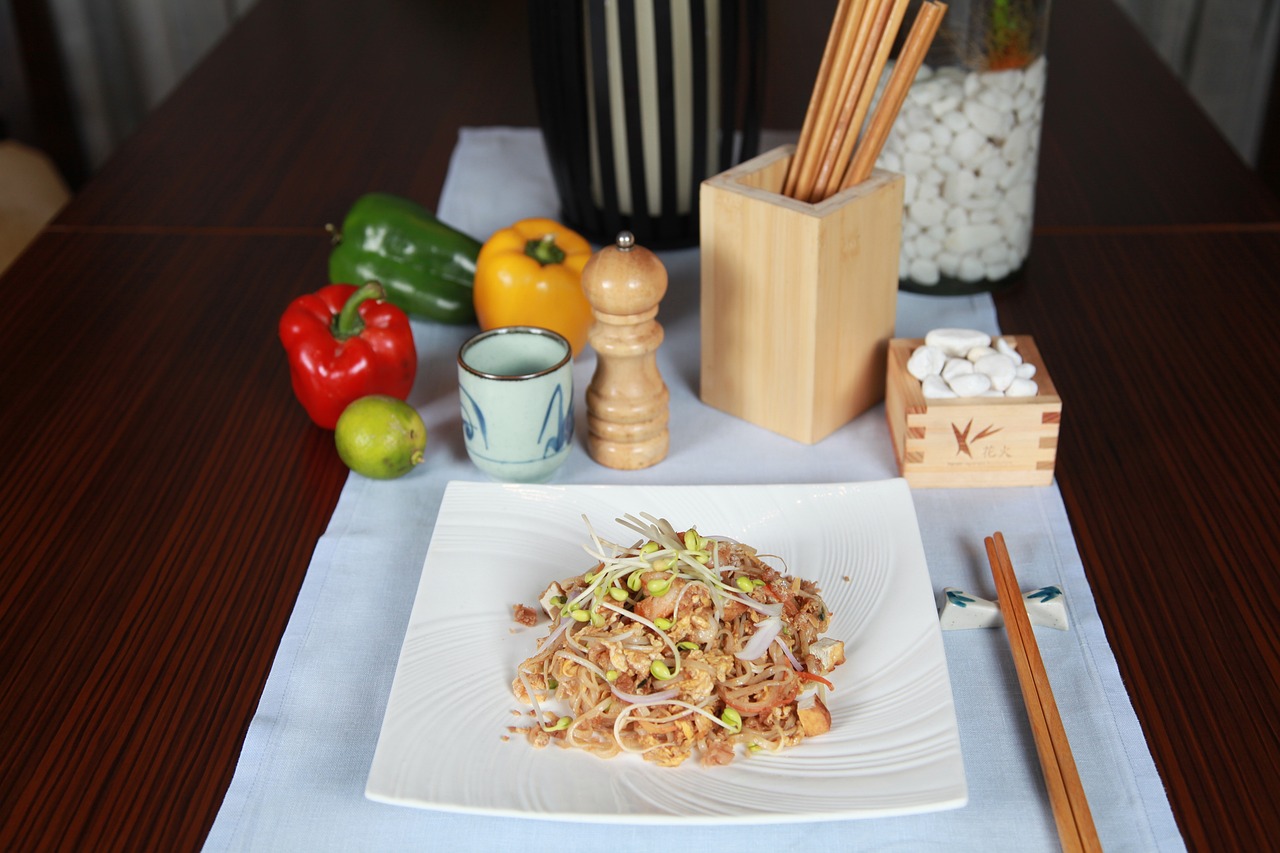Filipino Sinigang: Sour Tamarind Soup

Filipino Sinigang, also known as Sour Tamarind Soup, is a beloved dish in Filipino cuisine that tantalizes taste buds with its unique combination of sour and savory flavors. This traditional soup has a rich history and cultural significance in the Philippines, making it a staple in many households and restaurants across the country.
Sinigang's origins can be traced back to pre-colonial times when indigenous Filipino tribes used souring agents like tamarind, calamansi, or green mango to flavor their dishes. Over the years, Sinigang has evolved into a popular comfort food enjoyed by people of all ages, especially during rainy days or cold weather.
When it comes to ingredients, Sinigang typically features a medley of vegetables such as water spinach, radish, eggplant, and green beans, along with a choice of protein like pork, beef, shrimp, or fish. The sourness of the soup comes from tamarind, which gives Sinigang its signature tangy taste.
There are various regional and ingredient variations of Sinigang found throughout the Philippines, with each version adding a unique twist to the classic recipe. Some regions use different souring agents or include additional ingredients to enhance the flavor profile of the dish.
Preparing Sinigang involves a mix of traditional and modern cooking methods. While some prefer to simmer the soup slowly on the stovetop to extract the flavors of the ingredients, others opt for instant Sinigang mixes for a quick and convenient meal. Whichever method is chosen, the result is a comforting and flavorful soup that warms the soul.
Aside from its delicious taste, Sinigang also offers numerous health benefits. Packed with vitamins, minerals, and antioxidants from the vegetables and protein used in the dish, Sinigang is not only satisfying to eat but also nourishing for the body.
When serving Sinigang, it is best enjoyed piping hot with a side of steamed rice. The contrast of the sour soup with the fluffy rice creates a delightful balance of flavors. Additionally, Sinigang pairs well with condiments like fish sauce or soy sauce for added depth of taste.
Whether you're a fan of Filipino cuisine or looking to explore new flavors, Filipino Sinigang is a must-try dish that promises a burst of sourness and warmth in every spoonful. So, gather your ingredients, fire up the stove, and prepare to experience the explosion of flavors that Sinigang has to offer!
History of Sinigang
The history of Sinigang is a tale as rich and flavorful as the dish itself. Originating in the Philippines, Sinigang has been a beloved staple in Filipino cuisine for generations. This sour tamarind soup is not just a dish; it's a cultural icon that embodies the essence of Filipino flavors and traditions.
Sinigang's roots can be traced back to pre-colonial times when early Filipinos used souring agents like tamarind, calamansi, or green mango to flavor their dishes. Over the years, Sinigang has evolved and adapted, incorporating various meats, seafood, and vegetables to create a diverse range of recipes.
One of the defining characteristics of Sinigang is its unique blend of sourness and savory notes, creating a harmonious balance of flavors that tantalize the taste buds. The dish's ability to evoke a symphony of tastes is a testament to the ingenuity and creativity of Filipino cooks throughout history.
As Sinigang gained popularity across the Philippines, different regions began to put their own spin on the classic recipe. From the use of different souring agents to the choice of protein, each variation of Sinigang tells a story of local ingredients and culinary traditions.
Today, Sinigang has become a beloved comfort food enjoyed by people of all ages. Whether served in a humble household or a fancy restaurant, Sinigang continues to bring people together, sparking conversations and creating lasting memories around the dining table.
Ingredients and Variations
Sinigang, the beloved Filipino sour tamarind soup, boasts a rich array of ingredients and variations that contribute to its distinctive flavor profile. The key components that form the foundation of Sinigang include:
- Tamarind: The sour tamarind fruit serves as the primary souring agent in Sinigang, providing the characteristic tanginess that defines the dish.
- Meat: Common choices of protein for Sinigang include pork, beef, shrimp, or fish, each offering a unique taste and texture to the soup.
- Vegetables: Sinigang is typically loaded with an assortment of vegetables such as water spinach (kangkong), radish, string beans, eggplant, and taro corms, adding depth and nutrition to the dish.
- Seasonings: Garlic, onions, and fish sauce are often used to enhance the savory umami flavors of Sinigang.
While these ingredients form the core of traditional Sinigang recipes, variations abound across different regions of the Philippines and among individual households. Some popular variations include:
- Seafood Sinigang: Utilizing prawns, fish, or a mix of seafood for a lighter yet equally flavorful version of the soup.
- Beef Short Rib Sinigang: Featuring succulent beef short ribs that lend a rich and hearty essence to the dish.
- Chicken Sinigang: Offering a poultry twist to the classic recipe, perfect for those seeking a lighter alternative.
- Vegetarian Sinigang: Catering to plant-based diets by replacing meat with tofu or adding more vegetables for a wholesome meat-free option.
These diverse ingredient combinations and variations showcase the versatility and adaptability of Sinigang, allowing for a wide range of flavor profiles to suit different preferences and dietary requirements. Whether you prefer the traditional pork Sinigang or enjoy exploring innovative twists on this classic Filipino dish, there is a Sinigang variation to satisfy every palate.
Cooking Methods
When it comes to cooking Sinigang, there are various methods that can be employed to achieve that perfect balance of sourness and savory flavors. Let's delve into the traditional and modern ways of preparing this beloved Filipino dish:
- Stovetop Simmering: The most traditional method involves simmering the ingredients in a pot on the stovetop. This slow cooking process allows the flavors to meld together, resulting in a rich and flavorful broth.
- Pressure Cooker: For a quicker alternative, a pressure cooker can be used to prepare Sinigang in a fraction of the time. This method is ideal for those who want to enjoy this dish without the long simmering process.
- Instant Sinigang Mixes: In today's fast-paced world, instant Sinigang mixes have become popular for their convenience. These pre-packaged mixes contain all the necessary seasonings and can be easily dissolved in water to create a quick Sinigang soup.
- Slow Cooker: Another modern approach is using a slow cooker to prepare Sinigang. This hands-off method allows the ingredients to cook slowly over several hours, resulting in tender meat and a flavorful broth.
Each cooking method brings its own unique twist to the traditional Sinigang recipe, allowing home cooks to choose the technique that best fits their schedule and taste preferences. Whether you prefer the slow simmering process on the stovetop or the quick and easy preparation with instant mixes, the end result is always a comforting bowl of sour tamarind soup that warms the soul.
Health Benefits
Sinigang, the beloved sour tamarind soup of Filipino cuisine, not only delights the taste buds but also offers a plethora of health benefits. Packed with a variety of nutritious ingredients, Sinigang provides a wholesome dining experience that nourishes the body and soul. Let's delve into the health benefits that this flavorful soup brings to the table:
- Rich in Vitamins: Sinigang is typically loaded with vitamin C from the tamarind base, which boosts the immune system and promotes overall health.
- Mineral-Rich: Ingredients like leafy greens, radish, and other vegetables in Sinigang provide essential minerals like iron and calcium that are vital for maintaining strong bones and a healthy body.
- Antioxidant Power: The mix of vegetables and herbs in Sinigang offers a high antioxidant content, fighting off free radicals and reducing the risk of chronic diseases.
- Low in Calories: Sinigang is a light and low-calorie dish when prepared with lean meats and an abundance of vegetables, making it a great option for those looking to manage their weight.
- Gut Health: The sourness of tamarind in Sinigang can aid digestion and promote gut health, thanks to its probiotic properties that support a healthy digestive system.
With its nutrient-dense ingredients and savory broth, Sinigang not only satisfies your taste buds but also contributes to your overall well-being. So, next time you savor a steaming bowl of Sinigang, relish in the fact that you are indulging in a dish that not only delights but also nourishes your body from within.
Serving and Pairing
When it comes to serving and pairing Filipino Sinigang, there are several key aspects to consider that can elevate the dining experience. The sour tamarind soup is a versatile dish that can be enjoyed in various ways, making it a favorite among many Filipino households. Let's explore the best practices for serving and pairing Sinigang to fully appreciate its unique flavors.
First and foremost, Sinigang is typically served hot, making it perfect for warming up on a chilly day or enjoying a comforting meal. The steaming bowl of tangy soup is often accompanied by a generous serving of rice, which helps balance out the sourness of the broth. The combination of the savory soup and fluffy rice creates a satisfying and hearty meal that is both comforting and delicious.
For those looking to add some texture and depth to their Sinigang experience, crispy fried fish or pork can be served as a crunchy side dish. The crispy exterior of the fried protein provides a delightful contrast to the soft and tangy soup, adding a new dimension to each bite. This pairing is a popular choice among those who enjoy a mix of textures in their meals.
When it comes to beverages, Sinigang pairs exceptionally well with a refreshing glass of cold water or a chilled fruit juice. The coolness of the drink helps balance out the warmth of the soup, creating a harmonious contrast that enhances the overall dining experience. Additionally, some may opt for a light beer or a citrusy cocktail to complement the sour notes of the dish.
To enhance the flavors of Sinigang even further, consider serving it with a side of fresh vegetables or a zesty salad. The crispness of the vegetables provides a refreshing contrast to the rich and tangy broth, adding a burst of freshness to each spoonful. Additionally, a squeeze of calamansi or lime juice over the soup can enhance the citrusy notes and brighten the overall flavor profile.
Overall, serving and pairing Sinigang is a delightful experience that allows for creativity and personalization. Whether enjoyed with traditional accompaniments like rice and fried fish or paired with modern twists like a citrus cocktail, Sinigang is a dish that can be customized to suit individual preferences. By paying attention to the serving and pairing suggestions, you can elevate your Sinigang meal to new heights of flavor and enjoyment.



 HazalVardal
HazalVardal 





